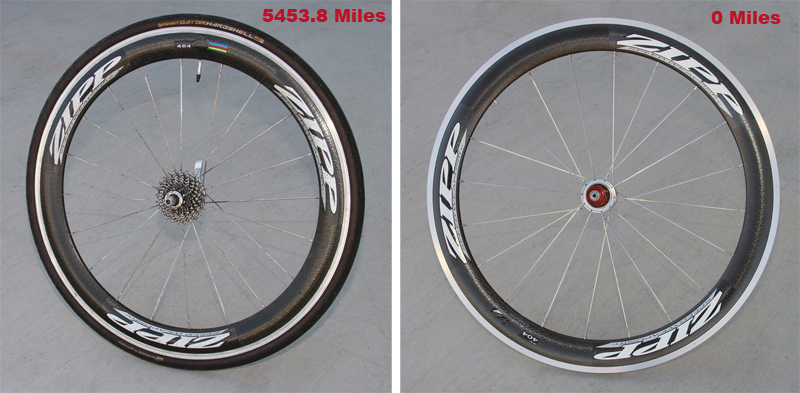By Tom Demerly
![zipptest120 copy]()
- After- and Before. The Zipp 404 on the left has 5,453.8 commuter miles on marginal roads. The 404 on the right is out-of-the-box new.
How durable is the 2011 Zipp 404 wheel in the real world? Can you ride them everyday? Are they durable enough for bad roads? And most importantly, if you buy Zipp 404 wheels will they last for a number of race seasons and retain their resale value?
We rarely get the time to test products over a span of a couple years. Product life cycles tend to run in model year, roughly 12-18 month cycles. Manufacturers time new introductions for the beginning of successive seasons when consumer interest in the latest and greatest is running high.
Until the recession.
The global recession has torpedoed discretionary spending among consumers and caused them to keep the things they buy longer and to shop discounts and sales carefully when they finally do buy. Even though our sport is purported to be “recession proof” when you look at race participation numbers (especially at Ironman) the economic environment has refocused consumer attention on value. Value is a good price for good equipment that lasts.
Two years ago I began riding a pair of new Zipp 2011 Zipp 404 clincher wheels. This is the pre-Firecrest wheel with the silver, brushed aluminum alloy braking surface, carbon fiber rim, one version removed from latest hub.
I commute to work nearly everyday and completed more bicycle commutes to and from TriSports.com than any other employee in 2010 and again in 2011. My commute is between 7.5 miles and 19.5 miles depending on the route. The direct, 7.5 mile route on Alvernon has mixed pavement but heavy traffic. I’ve been hit once by a van while commuting on this route and tried to resuscitate one pedestrian run over by a car. It’s a busy main street through a crowded central city area. The long 19.5 mile route is down Swan to Golf Links at the north end of Davis-Monthan Air Force Base. Circling Davis-Monthan takes you over Kolb Rd. and Wilmot Rd. then up Valencia. Each of these roads have wide bike paths but poor, sun cracked black asphalt. The route passes in front of the Pima Air Museum and through the famous Davis-Monthan AFB AMARG “Bone Yard” or storage facility for surplus U.S. and international military aircraft.
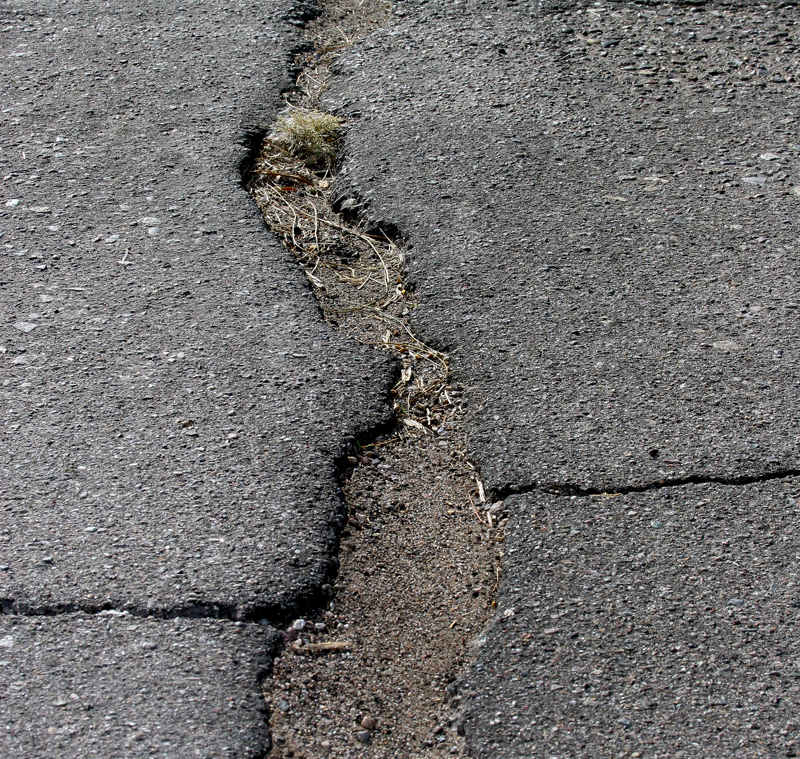
“The Zipp 404 wheel is likely the most popular aerodynamic wheel in the world.”
The Zipp 404 wheel is likely the most popular aerodynamic wheel in the world. Year after year at the Kona bike count Zipp brand wheels count for more race wheels than any other brand by a substantial margin and the majority of those are 404’s. The Zipp 404 is a “do everything” wheel. It’s 63 millimeter deep measured rim depth is optimal for cross winds, flat, rolling and even very hilly courses and has tested most effective across a wide range of yaw angles than any other rim depth. If you do a survey of the middle 90% of Ironman bike splits averaging between 17 and 22 M.P.H. the Zipp 404’s 63 mm rim depth is the best choice. In fact, when Steve Hed innovated the deep section aero wheel in the late 1980’s the original wind tunnel results suggested an “about 60 mm” rim depth would be the absolute optimal rim depth. Since then more aero wheel brands such as Zipp, HED, Mavic, Easton, Campagnolo, Shimano and many others have settled on the 60 millimeter rim depth as the de-facto “best” relationship of weight, durability and aerodynamics. The implication is clear: If you own one set of race wheels, buy 60 mm deep aero wheels.
The Zipp 404 clinchers I ride use a SRAM cogset and have rolled on three different rear Continental Gator Skin 700 X 25 c tires and two different Continental 700 X 23c front tires. I’ve lost 24 pounds since I started riding these wheels to and from work and weigh 161 pounds at 5’9″. I ride in all weather, from summer Tucson heat to the 31 degree low temps I rode in this morning and the rare Tucson gulley-flusher downpour.
Even with five flat tires, one minor collision with a car and literally thousands of chuck-hole strikes my Zipp 404’s are perfectly true. They have also retained spoke tension almost identical to a new wheel out of the box. There are minor scratches on the finish from hitting road debris but no damage tot he structural carbon or the alloy brake track. The hubs were adjusted once (tightened) at about 200 miles suggesting they were slightly lose out of the box from the factory. Once the bearing adjustment cap was turned down and the set screw torqued the hubs have stayed in adjustment for 5,453.8 miles.
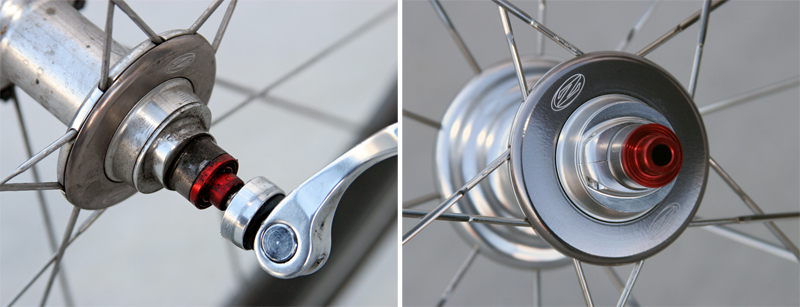
Zipp 404’s are hand made in Zipp’s assembly and manufacturing facility in Indianapolis, Indiana. I’ve toured the quality control and manufacturing facility including the areas where the rims are molded and finished. After seeing the process of laying up the carbon fiber and finishing the cured carbon fiber rims then hand assembling the wheels I wasn’t surprised that I got good durability from a stock set of wheels. the process is meticulously controlled and has been updated continuously since Zipp started making wheels in the 1980’s.
Close inspection of the areas where stress accumulates on wheels revealed no change in the wheel from when it was mounted. The areas surrounding the spoke nipple are intact and, once the road film is cleaned away from them, they appear as they did when new. The bladed orientation of the spokes has stayed in alignment with the wheel itself, suggesting the spokes have not twisted, bent or been deformed by impacts, wheel removal, loading the bike into a vehicle or from chuck hole strikes.
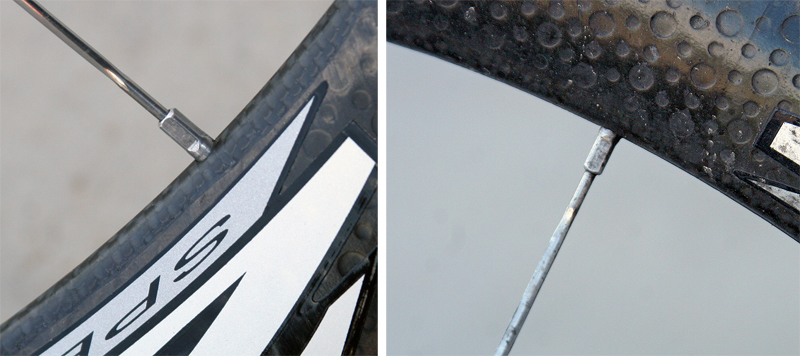
Another area we wanted to check for wear was the alloy brake track. While Zipp has spent significant resources on the design of their new carbon fiber brake tracks in wear, heat dissipation and stopping power the previous machined alloy brake track was proven and dependable. The southern Arizona, Tucson riding environment is a dust and sandy one. The weather is extremely dry so dust and sand accumulate in the braking system and on the pads. This has an abrasive effect on the rim surface. At 5453.8 miles my rims did show some brake wear, but not much. As a percentage of total rim wear, with 100% being completely worn out, I would suggest these rims are now as much as 15% worn after 5453.8 miles with frequent braking in the commuting environment. It is worth noting the same set of original equipment brake pads were used for the entire life of the wheels, and that those likely accelerated the wear of the rim section as they became laden with grit and road film. Another benefit to the alloy rim is that is uses a normal (non-carbon specific) brake pad that is extremely durable.

Shift performance, ride quality, sound and the other features of wheel performance have remained unchanged throughout the 5,453.8 mile ownership test. There has been no maintenance beyond the early hub adjustment performed on the wheels. Tire changes were performed when flat tires from foreign object punctures occured. Even with the accumulation of desert dust and grit the wheels have maintained good mechanical performance, braking, shifting and rolling.
Another feature to previous model year Zipp wheels is the economic component of the ownership experience. Zipp wheels purchased new from an authorized dealer come with Zipp’s warranty against defects to the original owner. Wheels purchased in the secondary market such as auction sites or Internet classifieds do not have warranty support from Zipp but still command prices close to- or even above- current pricing on previous model year Zipp 404’s sold through authorized Zipp dealers. Since previous model year Zipp wheels tend to hold their resale value relative to other brands there is an economic component to the Zipp brand missing from other brands. For any consumer dubious about carbon rims, the prior alloy rim Zipp 404 remains attractive, especially with these late model hubs.
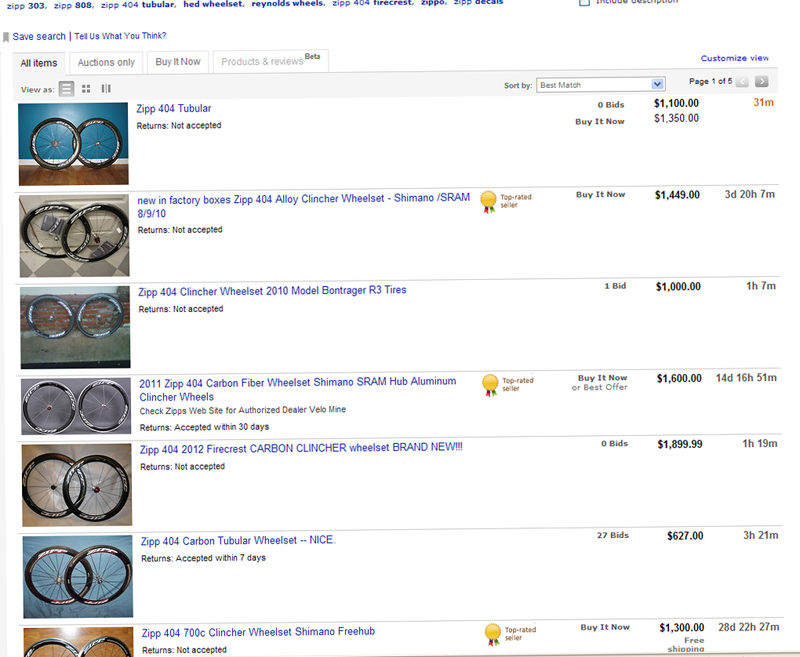
While it is unusual for us to be able to test any product over 20 months of continuous use in all settings this test proved interesting since the 2011 Zipp 404 exceeded our expectations for impact resistance, wear and mechanical reliability. The wheels also command near-new resale value in the secondary market.
Zipp makes continuous improvements to their wheels with on-going weight reduction, aerodynamic improvements and other design updates. These updates are made so quickly that prior version wheels often still exceed the performance standards of competing brands and offer exceptional value.

The Zipp 404 is the classic aerodynamic performance wheel. I’ve stopped referring to them as “race wheels” since that suggests some exclusion from the ability to be used every day. That isn’t true with these wheels. They are fast on race day and they are durable and mechanically dependable enough for everyday use. Every wheel can be damaged by a chuck hole strike, crash, mishandling on a car rack or packing case. Those are not warranty situations- they are accidents in the normal course of race wheel use and not covered by a warranty. The everyday wear and tear on the wheels did not induce any damage or wear even after 5453.8 miles in tough, real world conditions. That is an impressive result. The 2011 version of the Zipp 404 has truly stood up to the test of time and distance.

